
American football’s modern history spans from the early 20th century to its current status as one of the most popular sports in the U.S. In the early 1900s, pivotal rule changes, such as the 1906 introduction of the forward pass, made the sport more exciting and less dangerous. The NFL was founded in 1920, establishing professional football as a major force. Key developments in the mid-20th century history included the 1946 integration of African American players, helping to break racial barriers, and the first NFL Championship Game broadcast in 1958, which significantly increased the sport’s visibility.
The 1970s saw the NFL merge with the AFL, creating the Super Bowl and making it a cultural phenomenon. As the NFL grew into the late 20th century with 32 teams, it cemented its place as the leading professional football league. Moving into the 21st century, the league implemented player safety measures, such as rule changes to combat concussions and ensure player well-being. Today, the NFL continues to be a cornerstone of American culture, with the Super Bowl standing as one of the largest sporting events in the world.
Modern History of intercollegiate football (1933–present)
Modernization of intercollegiate American football (1933–1969)
From 1933 to 1969, intercollegiate American football modern history experienced significant changes that impacted its structure, popularity, and cultural relevance. The 1930s marked the continued growth of the sport, especially in the South, where legendary rivalries like the “South’s Oldest Rivalry” between Virginia and North Carolina, and the “Deep South’s Oldest Rivalry” between Georgia and Auburn emerged.
Power programs were concentrated in the Northeast and Midwest, but the rise of successful teams from the South and West Coast shifted the landscape, making college football the dominant spectator sport in the South. The history of the Southwest Athletic Conference, formed in 1915, was marked by national champions such as Texas Christian University and Texas A&M.
The Southeastern Conference (SEC) was formed in 1932 and dominated the Deep South, while the Big Ten maintained its dominance in the 1930s and 1940s, with Minnesota, Michigan, and Ohio State claiming national titles. In the 1930s, bowl games like the Orange Bowl, Sugar Bowl, Sun Bowl, and Cotton Bowl emerged, providing national visibility for teams across the country. In 1936, the Associated Press began ranking college football teams, and its final poll was used to crown the national champion.
Rule changes in the 1930s helped foster the growth of the passing game, with players like Don Hutson and “Slingin” Sammy Baugh benefiting from these modifications. The Heisman Trophy, introduced in 1935, became a prestigious award with its first winner, Jay Berwanger.
World War II saw many college players enlist, and after the war, Army, with players like Doc Blanchard and Glenn Davis, won back-to-back national titles and had Heisman winners. The history of the 1950s brought the rise of powerhouses like Oklahoma, Ohio State, and Michigan State, while the running game became more dominant than the passing game. In 1956, Bobby Grier made history as the first black player to participate in the Sugar Bowl, marking an important step in the integration of college football.
Modern intercollegiate football (1970–present)
Since 1970, the modern history of intercollegiate American football has experienced remarkable growth and transformation, becoming a staple of American culture. The 1970s marked the expansion of bowl games, allowing more teams the chance to compete in postseason play, while the integration of African American players brought much-needed diversity to the sport. The 1980s and 1990s introduced the Bowl Championship Series (BCS) in 1998, aiming to definitively identify a national champion through a combination of polls and computer rankings. This period also saw schools changing conferences to improve competitiveness and financial opportunities.
The 2000s saw the introduction of the College Football Playoff (CFP) system in 2014, which replaced the BCS and established a four-team playoff format to crown the national champion, with the playoff set to expand to 12 teams by 2024. Additionally, the number of bowl games continued to increase, reflecting the sport’s rising popularity and commercialization. These developments have contributed to making intercollegiate football a more inclusive, competitive, and widely celebrated part of American society.
The rise in bowl games in American college football reflects the sport’s growing popularity and commercialization. Early on, the number of bowl games was limited to a few prestigious contests like the Rose Bowl, Sugar Bowl, and Orange Bowl. But as the sport gained momentum, particularly after the 1970s, the number of bowl games began to grow rapidly. In 1970, there were only eight bowl games, but as media coverage and fan interest expanded, so did the number of postseason opportunities.
During the 1980s and 1990s, the number of bowl games grew to 20-25, offering more teams a chance to compete in postseason play. This growth was driven by the increasing financial rewards for universities and the sport’s expanding national exposure. The late 20th century saw the emergence of smaller bowl games like the Liberty Bowl and Independence Bowl, providing a stage for mid-tier teams to showcase their skills.
By the 2000s, bowl games became a fixture of college football, with over 40 scheduled each year by the 2010s. The commercialization of the sport, fueled by television rights deals, played a pivotal role in this expansion. As the number of bowl games continued to rise, more teams, even those with less impressive records, were given a chance to compete before national audiences. By the 2020s, the number of bowl games surpassed 40, with the College Football Playoff (CFP) now serving as the final stage for determining the national champion. This trend reflects the growing significance of postseason play in college football, with bowl games evolving into major financial and cultural events for all involved.
Bowl Championship Series (1998–2013)
The Bowl Championship Series (BCS) served as the method for crowning the national champion in NCAA Division I FBS college football from 1998 until 2013. It was introduced to replace the previous system, which depended on polls and the outcomes of various bowl games, aiming to create a more standardized and definitive way of determining a champion. However, it continued to face criticism, especially for lacking a playoff system.
Under the BCS, the final rankings were determined by a combination of the Associated Press (AP) Poll, Coaches’ Poll, and several computer rankings. The top two teams would then face each other in the BCS National Championship Game, hosted at a rotating neutral site. Alongside this game, four major bowl games—known as the BCS bowls—included the Rose Bowl, Sugar Bowl, Orange Bowl, and Fiesta Bowl, which featured highly-ranked teams and offered automatic bids for conference champions.
Although the BCS system was more structured than previous methods, it was often criticized for being unfair, particularly towards teams in smaller conferences that were excluded from major bowl games. Despite the criticisms, the BCS era produced some unforgettable moments in college football, such as the famous 2006 Rose Bowl between Texas and USC.
In 2014, the BCS was replaced by the College Football Playoff (CFP), which introduced a four-team playoff system to select the national champion, responding to many of the concerns about fairness and inclusivity. The CFP format has expanded to 12 teams, providing even more opportunities for teams to compete for the title.
College Football Playoff (2014–present)
The College Football Playoff (CFP), implemented in 2014, revolutionized the process for crowning the national champion in NCAA Division I FBS college football. It replaced the Bowl Championship Series (BCS) and introduced a four-team playoff format, with teams selected by a committee based on factors such as performance, strength of schedule, and conference championships. These four teams face off in two semifinal games, which rotate among major bowl games, with the winners advancing to the CFP National Championship Game. This new system offered a clearer, more competitive method for determining the national champion, addressing the criticisms and controversies of the BCS rankings.
In 2023, the CFP announced a major expansion to a 12-team format, set to take effect in 2024. The expanded format includes automatic bids for the six highest-ranked conference champions, with the next six highest-ranked teams receiving at-large spots. The top four seeds will earn a first-round bye, while the remaining teams will compete in the first round at the higher-seeded team’s home stadium. The following rounds will be played in the New Year’s Six bowl games, with the final championship game held at a neutral site. This expansion aims to make the postseason more inclusive and provide more opportunities for teams and fans to engage with the excitement of college football.
Modern History of professional football
(1933–present)
Professional football (1933–1969)
Between 1933 and 1969, The modern History of professional American football went through significant developments that defined its modern form and popularity. In 1933, the NFL introduced its annual championship game, splitting the league into two divisions, which set the stage for the current playoff system. During this time, the league expanded with the addition of teams like the Pittsburgh Steelers and Philadelphia Eagles.
The 1946 integration of the NFL, including the signing of African American players such as Kenny Washington, marked a critical moment in the sport’s history. The 1950s saw the NFL further expand by merging with teams from the now-defunct All-America Football Conference (AAFC), including the Cleveland Browns and San Francisco 49ers. In the 1960s, the American Football League (AFL) emerged as a competitor to the NFL, leading to the creation of the Super Bowl in 1967, which symbolized the two leagues’ eventual merger. This era laid the groundwork for the NFL’s commercialization and solidified its place as a key part of American sports culture.
Stability and growth of the NFL (1933–1957)

George Preston Marshall (right) and NFL Commissioner Bert Bell (center) met with President Harry S. Truman at the White House in September 1949.
From 1933 to 1957, the National Football League (NFL) entered a period of growth and stability that laid the groundwork for its future dominance in American sports. A pivotal moment in 1933 was the reorganization of the league into two divisions (Eastern and Western), which led to the creation of the annual NFL championship game. This reorganization helped to enhance competition, standardize the league’s structure, and make it more professional, all of which increased its appeal to fans.
During the 1940s, the history NFL made significant strides by breaking racial barriers and signing African American players like Kenny Washington and Woody Strode in 1946. This integration, coupled with the NFL’s expanding popularity, broadened its fan base and boosted its national significance. The 1950s saw further league expansion with the addition of teams from the All-America Football Conference (AAFC), such as the Cleveland Browns, San Francisco 49ers, and Baltimore Colts. This infusion of new teams brought added competitiveness and heightened interest in the league.
The 1950s also saw the NFL cement its place in American culture, aided by the rise of television and increased media coverage. The league’s combination of competitive teams, growing fan interest, and rising media visibility allowed it to move beyond its regional origins, setting the stage for its rise as a national—and eventually global—sports powerhouse.
The Greatest Game Ever Played (1958)

The 1958 NFL Championship Game, known as “The Greatest Game Ever Played,” is considered a defining moment in the history of American football. Played on December 28, 1958, at Yankee Stadium in New York, the game featured a thrilling matchup between the Baltimore Colts and the New York Giants, going into overtime for the first time in NFL history. This historic game helped popularize the NFL, drawing national attention and contributing to the growth of the sport in the years that followed.
This game is seen as a turning point for professional football, significantly increasing the sport’s popularity and national exposure. With the Colts led by quarterback Johnny Unitas and the Giants starring quarterback Charley Conerly, both teams showcased outstanding performances, keeping the game intensely competitive. The game was a back-and-forth affair, with both teams swapping leads throughout regulation.
The pivotal moment came in overtime when Colts kicker Steve Myhra’s field goal gave Baltimore a 23-17 victory. Unitas’s performance, highlighted by a crucial drive that tied the game late in regulation, and the thrilling overtime conclusion, made this contest unforgettable. The excitement surrounding the game sparked public interest, contributing to the NFL’s rise as a major American sport. The 1958 NFL Championship is often credited with helping the league expand its fan base and visibility, paving the way for its future success.
American Football League, merger and Vince Lombardi
(1959–1969)
From 1959 to 1969, the modern history of professional American football saw key developments, most notably the creation of the American Football League (AFL) and the influential leadership of Vince Lombardi.
Formation of the American Football League (AFL)

Lamar Hunt, a Texas entrepreneur, founded the AFL in 1959 as a direct competitor to the well-established NFL. The league began its first season in 1960 with eight teams and a 14-game schedule. The formation of the AFL increased competition for players and fan attention, resulting in higher salaries and a surge in the sport’s popularity.

On June 8, 1966, the rivalry between the AFL and NFL was resolved with the announcement of a merger agreement. The leagues continued with separate regular-season schedules until 1969, with a championship game between the AFL and NFL champions, known as the Super Bowl. The merger took full effect in 1970, creating a single league divided into two conferences.
- NFL – Being the more established and older league, the NFL included teams such as the Green Bay Packers, New York Giants, and Chicago Bears at its core. It was seen as the more traditional league, boasting a strong and committed fan following.
- AFL – Starting with eight teams in 1960, the AFL became known for its exciting, high-scoring games, distinguishing itself from the NFL’s more traditional approach. The league was also notable for its inclusiveness of African American players and its pioneering strategies in securing television rights deals.
Vince Lombardi’s Coaching Career (1959–1969)

Vince Lombardi began his NFL coaching career as the offensive coordinator for the New York Giants in 1954. In 1959, he became the head coach and general manager of the Green Bay Packers, guiding the team to five NFL championships, including the first two Super Bowls in 1967 and 1968. Lombardi was well-known for emphasizing discipline, hard work, and a potent running game. His approach to coaching and his remarkable success made him one of the NFL’s most iconic figures in history, and the Super Bowl trophy was later renamed in his honor, cementing his legacy as one of the greatest coaches in the sport’s history.
In 1969, Lombardi assumed the role of head coach and executive vice president for the Washington Redskins in an effort to rebuild the team. Sadly, his tenure was cut short when he passed away from cancer in September 1970.
The period from 1959 to 1969 was a transformative time for professional American football, driving competition, integration, and the creation of the Super Bowl as a key sporting event.
Professional football (1970–present)
Since the merger of the NFL and AFL in 1970, professional American football has seen significant growth and change, cementing its role as a central part of American life. Following the merger, the NFL expanded from 26 to 32 teams by 2002, introducing realignment that created a more balanced competitive landscape with distinct divisions and conferences. The playoff system grew over time, culminating in a major expansion in 2020, which increased the playoff teams to 14, amplifying postseason competition and enhancing fan engagement.
The Super Bowl, initially a contest between AFL and NFL champions, has evolved into a cultural phenomenon, attracting millions of viewers each year. It is now famous not only for the game but also for its high-profile commercials and elaborate halftime shows, making it a national event. Along with these developments, the NFL has made strides in player safety, introducing rules to reduce head injuries and concussions. The league has also been active in supporting social causes, reflecting societal movements and taking action on social justice issues. Today, professional football remains an inclusive, competitive, and celebrated sport at the heart of American society.

The NFL, following its merger with the American Football League (AFL) in 1970, entered a period of unprecedented stability, growth, and expansion. The merger formed a 26-team league that would later increase to 32 teams and introduced the conference system that still exists today, with the NFL divided into the American Football Conference (AFC) and the National Football Conference (NFC), each containing four divisions. This structure helped create competitive balance and foster regional rivalries across the league.
A major result of the merger, the Super Bowl, evolved into the crown jewel of the NFL’s postseason, eventually becoming the most-watched annual sporting event in the United States. The Super Bowl has grown beyond a mere championship game to a massive cultural event, featuring renowned halftime performances, eagerly anticipated commercials, and a significant media presence.
As the league expanded, the NFL modified its playoff system to include more teams and additional rounds of competition. In 2020, a third wild card team from each conference was added, increasing the playoff field to 14 teams and further intensifying the postseason battles.
The NFL also took strides to improve player safety by instituting stricter rules to reduce head injuries and helmet-to-helmet hits, alongside stronger concussion protocols. More recently, the league has engaged in social and political issues, supporting social justice initiatives and encouraging players to use their platform for activism.
Overall, the post-merger NFL became a more inclusive, commercially viable, and culturally significant institution, securing its place as the most popular sport in the U.S.
Aside form the National Football League ( NFL ) , several other professional football league have had impact on the growth and popularity of American Football. These leagues offer additional avenues for players, coaches , and fans to engage with the sport, frequently focusing on targeted markets or offering alternative formats for football entertainment.
- Canadian Football League (CFL) – stands as the premier professional football league in Canada. Founded in 1958 and offers a unique style of play that differs from the NFL. The league features a larger field and a three-down system, which shapes the gameplay. With iconic teams like the Toronto Argonauts and Calgary Stampeders maintaining strong traditions. The CFL has earned a loyal following in Canada. While it may not have the same recognition as the NFL, the CFL remains a key professional football league in North America.
- XFL – The XFL is a professional football league created by Vince McMahon, the chairman and CEO of WWE . Originally launched in 2001 and was reintroduced in 2020. its goal is to offer a faster-paced, fan-centric alternative to NFL. With unique rule changes such as shorter game times and a focus on innovation, the XFL sought to differentiate itself from other leagues. However, the league has faced financial challenges and, despite several attempts to revive it, has been shut down and restarted on multiple occasions.
- United States Football League (USFL) -The United States Football League (USFL) was established in 1982 to challenge the NFL but folded after just three seasons in 1985. In 2022, the USFL made a comeback, designed to offer an alternative for football fans during the NFL’s offseason. The current USFL continues to operate professionally, with teams like the Birmingham Stallions and Philadelphia Stars, and places an emphasis on providing players with a platform to hone their skills in a competitive environment.
- Alliance of American Football (AAF) – the AAF established in 2018, sought to provide a competitor to the NFL, focusing on player development and testing new game rules and technologies. The league began its inaugural season in 2019 but ran into financial challenges and ended operations before finishing the season.
- Indoor Football Leagues – The Arena Football League (AFL) and the Indoor Football League (IFL) are among the indoor football leagues that feature fast-paced, high-scoring games in compact arenas. Teams such as the Arizona Rattlers and Spokane Shock have built dedicated followings. Though less widely recognized than the NFL, these leagues offer fans a more personal and thrilling football experience.
- European and International Leagues – Although the NFL dominates American Football, professional football league can also be found in Europe and beyond. The German Football League (GFL) is one of Europe’s premier leagues, known for its competitive football. International league like the Japan X League offer players outside of North America the opportunity to pursue professional football careers, though leagues typically operate on a smaller scale.
Modern History of youth and high school football
(1933–present )
Over the period from 1933 to today, youth and high school football in the U.S. have gone through substantial developments, establishing themselves as a core element of American culture.
Early Developments (1930s–1940s) – American football was primarily a collegiate and professional sport in the early 20th century, but the 1920s and 1930s saw the rise of youth sports programs, with football gaining widespread popularity at the school level. The establishment of high school sports associations formalized the rules and schedules, resulting in a more competitive and organized environment.
Joseph J. Tomlin founded the first youth football league in Philadelphia in 1929 as a crime prevention initiative. Initially a four-team league, it expanded to sixteen teams in 1933 when Pop Warner, the newly appointed coach at Temple University, agreed to lecture the boys. The league was renamed the Pop Warner Conference in his honor. Today, Pop Warner Little Scholars includes over 300,000 boys and girls, ages 5–16, in more than 5,000 football and cheerleading squads, with programs extending to Mexico and Japan.
Post-World War II Expansion (1940s–1960s) – Following World War II, the Baby Boomer generation sparked a massive increase in youth sports participation. The founding of Little League Baseball in 1939 marked a turning point in organized youth sports, paving the way for millions of young athletes to engage in competitive activities across the nation.
High school football became a cultural cornerstone in many American communities, particularly in states like Texas and Ohio. Games frequently served as major social events, attracting large crowds and helping to build local identity. The National Federation of State High School Associations (NFHS), founded in 1920, was instrumental in setting standardized rules and supporting the growth of high school football throughout the country.
Modern Developments (1970s–Present) – in decades youth and high school football faced challenges associated to players safety, particularly concerning concussions and other head injuries. This had led to increased significance on proper techniques, the use of advanced protective equipment, and the actualization of concussions protocols. Organizations like USA football have introduced programs to educate coaches and players on safety measures and proper playing techniques.
Football has become more inclusive in recent years, with flag football—a non-contact variation—growing in popularity, especially among girls. In 2025, Ashlea Klam, a 20-year-old flag football world champion from Texas, was setting her sights on an Olympic gold medal for the U.S. team at the 2028 Los Angeles Olympics, reflecting the sport’s expanding reach.
In general, youth and high school football in the United States have shifted from informal neighborhood games to structured, competitive sports that play an important role in community culture and the larger sports landscape.
Modern History of American football outside the United States
(1933–present)
American football has been expanding internationally since 1933, spreading through leagues, global competitions, and cultural exchanges. Countries like Canada and Japan were introduced to the sport in the early 1900s, with Japan holding its first official game in 1934. After World War II, American football gained popularity in Europe, leading to the creation of leagues like the German Football League in 1979. The NFL began its international outreach with exhibition games in the 1970s and 1980s, including the American Bowl series, which brought preseason games to the U.K., Germany, and Japan.
In 2005, the NFL marked a major achievement by hosting its first regular-season game outside the U.S. in Mexico City, and since then, games have been played in London, Germany, and Brazil, with future matches planned in Madrid and Dublin. Competitions like the IFAF World Championship have played a key role in growing the sport internationally, and the addition of flag football to the 2028 Summer Olympics signals the sport’s growing appeal around the world.
ALSO READ :
